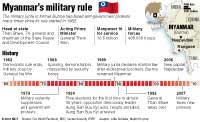
Article
How did the crisis in Myanmar rise to a boil—and how are the world’s leading nations responding to the situation?
Learn the why behind the headlines.
Subscribe to the Real Truth for FREE news and analysis.
Subscribe NowA British colony for 62 years, the Union of Burma gained its independence in 1948. Looking forward to a peaceful and successful future, the people of Burma organized a fledgling democratic government in the capital city of Rangoon.
However, despite initial hopeful intentions, attempts to organize dozens of minority interests, ethnic groups and political factions—all of which spoke different languages and dialects—into a cohesive and productive unit of government proved utterly unworkable.
Leaders of minority groups such as the Shan, Kachin, Rohanis and Karen were given autonomous authority within the new government—and each quickly began to position and maneuver for wealth, power, influence and status for their own faction, group or geographical region. This focus on personal gain—as opposed to stabilizing the new collective country for the people and common good—led to a disastrous splintering of the government. Burma descended into chaos overnight.
Although many still blame the British for the confusion left in their departure, the land and its peoples had problems before, during and after British colonial rule. The region had been an area of violent conflict for centuries. Absent of the relative peace and organization found under the British rule, Burma quickly found itself under the control of power-hungry military leaders, each scrambling to finance his own guerrilla army to accumulate power. Citizens were caught in the crossfire, as aspirations for peace and prosperity were replaced with doubt, fear and an uncertain future.
During the mid-20th century, Burma was the wealthiest nation in Southeast Asia, due to its immense natural resources. The country was blanketed with millions of acres of forest containing valuable timber such as teakwood. In addition, Burma’s “Valley of Rubies” supplied over 90% of the world’s rubies. Vast and seemingly limitless pools of oil and collections of natural gas lay underground waiting to be collected and distributed around the world.
However, instead of these natural resources being utilized to pursue economic development, these were used to finance the oppression of the very people to whom the resources belonged.
For decades, the Burmese have continued to strain under this oppression, and in recent years nothing has changed. Since 1988, a military junta called the State Law and Order Restoration Council (SLORC) has controlled the nation. First led by General Ne Win, the junta seized control and renamed the country Myanmar.
Rumors began to circulate of violent “ethnic cleansing” and brutal suppression of opposition voices in the remote northern jungles and along the border with Thailand. No matter how peaceful the dissent of the Burmese citizens, the junta imprisoned and sometimes executed them, under the guise of restoring order in a state of tumult.
The junta’s tactics went largely unnoticed, or at least unaddressed, by neighboring countries and international powers—leading the government to further silence opposition by interrogating and imprisoning thousands more. Eventually it arrested the most adamant voice for freedom in the country, Aung San Suu Kyi, leader of the Burmese National League for Democracy. Dr. Suu Kyi was awarded the Nobel Peace Prize in 1991.
Finally, to calm internal uprisings and restore confidence on the world stage that the junta’s ultimate intentions were to return democratic power to the people, the SLORC allowed national elections in 1990. This resulted in a landslide mandate that elected the National League for Democracy. There was a feeling of hope among the citizenry that the winds of change were finally beginning to blow.
However, the junta maintained control as if the elections had never occurred. In fact, it used the elections as a tool to identify leading democratic voices, and then carry out systematic reprisals against them.
Although Dr. Suu Kyi was released due to international pressure, the country has been in a frenzied free-fall since the failed elections. In the wake of the junta’s refusal to honor election results, governments around the world bickered, held summits and “talked” for almost 20 years. All efforts failed to find a consensus in determining the steps needed to bring peace and security to Myanmar.
 MCT
MCTThe reason there has been no harmony in solving Myanmar’s situation is easily seen when the driving force behind each government’s actions are identified for what they truly are: sheer, unadulterated greed and self-interest. Providing peace and stability in Myanmar because it is the right thing to do has been tacitly reduced to an ancillary benefit by every nation involved. Of course, no government would admit this, however, world governments fall into two basic categories with regard to Myanmar: (1) those with economic ties to the junta; (2) those who worry that a well-armed military in Myanmar could threaten their own national security or international interests.
Instead of focusing on the absolute urgency to find a solution now, governments continue to hold summits and posture on the world stage to ensure they appear sufficiently distraught as they carry on “business as usual.”
Meanwhile, hundreds of thousands in Myanmar seek refuge in neighboring countries, as a humanitarian nightmare of epic proportions continues to unfold.
Just how bad have the current conditions in Myanmar become? Can the existing totalitarian rule guide its people to economic and social prosperity? Where does the real solution lie?
- Real Truth Magazine Articles
- GEOPOLITICS
 Inside Myanmar: Cycle of Failure – A Five-Part Series
Inside Myanmar: Cycle of Failure – A Five-Part Series
Other Related Items:
- Inside Myanmar – Part 2: Greed, Self-Interest and Destruction From Within
- Inside Myanmar – Part 3: The Driving Force Behind International Response
- Inside Myanmar – Part 4: Democracy’s Cycle of Failure
- Inside Myanmar – Part 5: The Only Solution


